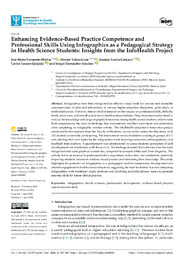Please use this identifier to cite or link to this item:
https://hdl.handle.net/11000/34762Full metadata record
| DC Field | Value | Language |
|---|---|---|
| dc.contributor.author | Navarrete-Muñoz, Eva María | - |
| dc.contributor.author | Valera-Gran, Desireé | - |
| dc.contributor.author | Garcia-Campos, Jonatan | - |
| dc.contributor.author | Lozano-Quijada, Carlos | - |
| dc.contributor.author | Sánchez-Hernández, Sergio | - |
| dc.contributor.other | Departamentos de la UMH::Patología y Cirugía | es_ES |
| dc.contributor.other | Departamentos de la UMH::Ciencias del Comportamiento y salud | es_ES |
| dc.date.accessioned | 2025-01-16T19:55:31Z | - |
| dc.date.available | 2025-01-16T19:55:31Z | - |
| dc.date.created | 2024-04-02 | - |
| dc.identifier.citation | Eur J Investig Health Psychol Educ . 2024 Apr 2;14(4):929-940 | es_ES |
| dc.identifier.issn | 2174-8144 | - |
| dc.identifier.uri | https://hdl.handle.net/11000/34762 | - |
| dc.description.abstract | Infographics have been recognised as effective visual tools for concise and accessible communication of data and information in various higher education disciplines, particularly in medical education. However, there is a lack of research on their impact on professional skills, difficulty levels, motivation, and overall satisfaction in health science students. Thus, the present study aimed to analyse the knowledge and usage of graphical resources among health science students and evaluate their competencies, the level of challenge they encountered, and their motivation and satisfaction after completing an infographic creation activity. The InfoHealth educational innovation project, conducted by five teachers from the Faculty of Medicine, served as the context for this study, with 143 students voluntarily participating. The intervention involved students working in groups of 2–3 and selecting their own topics for the infographics while receiving instruction, online guidance, and feedback from teachers. A questionnaire was administered to assess students’ perception of skill development and satisfaction with the activity. The findings revealed that schemes were the most recognized and used graphical summaries, compared to synoptic tables and Venn diagrams. The activity led to an increase in professional skills acquisition, motivation, and satisfaction, positively impacting students’ interest in evidence-based practice and reinforcing their knowledge. This study highlights the potential of infographics as a pedagogical tool for competency development and student engagement in health science education, suggesting the need for further research comparing infographics with traditional study methods and involving multidisciplinary teams to promote essential skills for future clinical practice. | es_ES |
| dc.format | application/pdf | es_ES |
| dc.format.extent | 12 | es_ES |
| dc.language.iso | eng | es_ES |
| dc.publisher | MDPI | es_ES |
| dc.rights | info:eu-repo/semantics/openAccess | es_ES |
| dc.rights | Attribution-NonCommercial-NoDerivatives 4.0 Internacional | * |
| dc.rights.uri | http://creativecommons.org/licenses/by-nc-nd/4.0/ | * |
| dc.subject | infographics | es_ES |
| dc.subject | health sciences | es_ES |
| dc.subject | professional development | es_ES |
| dc.subject | evidence-based practice | es_ES |
| dc.subject | communication skills | es_ES |
| dc.title | Enhancing Evidence-Based Practice Competence and Professional Skills Using Infographics as a Pedagogical Strategy in Health Science Students: Insights from the InfoHealth Project | es_ES |
| dc.type | info:eu-repo/semantics/article | es_ES |
| dc.relation.publisherversion | 10.3390/ejihpe14040060 | es_ES |

View/Open:
Enhancing Evidence-Based Practice Competence and Professional Skills Using Infographics as a Pedagogical Strategy in Health Science Students. Insights from the InfoHealth Project.pdf
272,25 kB
Adobe PDF
Share:
.png)
